Abstract
Porous carbons for CO2 capture were synthesized from a sulfur-rich bituminous coal via a one-step method concurrently including carbonization and KOH activation. The activation parameters were controlled by varying KOH/coal mass ratios (1:1, 2:1, and 3:1) and temperatures (700 °C, 800 °C, and 900 °C) to optimize their CO2 capture performance. The surface physicochemical structural properties of these porous carbons were characterized by applying a Brunauer–Emmett–Teller (BET) surface area analysis, scanning electron microscopy (SEM), X-ray photoelectron spectroscopy, and Raman spectroscopy. The results show that the SBET of sample SCC-800-3 is as high as 2209 m2/g, the CO2 adsorption capacity of sample SCC-700-2 at normal temperature and pressure reaches 3.46 mmol/g, and the CO2/N2 selectivity of sample SCC-700-1 reaches 24. The synergistic effect of moderate activation conditions ensures optimal pore evolution without compromising sulfur species retention. Furthermore, these porous carbons also demonstrate excellent cycling stability and thermal stability. The fitting of the adsorption isotherm model for all samples were further conducted. Adsorption isotherm modeling demonstrated superior fitting accuracy with the dual-parameter Freundlich and tri-parametric Redlich–Peterson formulations across all samples, indicating that the CO2 capture by high-sulfur coal-based porous carbons belongs to multilayer adsorption and the carbon surface is heterogeneous. The CO2 adsorption on porous carbon exhibits spontaneous, exothermic behavior according to the thermodynamic data. These findings confirm the great potential of high-sulfur coal-based porous carbons on the capture of CO2. The presenting research provides a strategy that leverages the synergistic effect of in situ sulfur doping and milder activation conditions, achieving the high-efficiency utilization of high-sulfur coal resources and developing low-cost CO2 capture materials.
1. Introduction
In the past few decades, the improper burning of fossil fuels has led to massive emissions of greenhouse gases, exceeding the Earth’s ability to capture and restore the carbon using the natural carbon cycle. Therefore, it is extremely urgent that we reduce the CO2 emissions to the atmosphere [1]. Carbon capture, utilization, and storage (CCUS) technology, as a prominent CO2 emission reduction approach, effectively mitigates the environmental effects from CO2 while transforming it into commercially viable compounds [2,3]. The most energy-intensive step in the CCUS technology is the first step, CO2 capture, accounting for 60–70% of the total cost of a CCUS project. Therefore, developing low-cost CO2 capture technologies has become a hot research topic [4]. The three primary carbon capture methods are pre-combustion, oxy-fuel combustion, and post-combustion capture: pre-combustion requires high temperatures and costly infrastructure, limiting scalability; and oxy-fuel combustion demands energy-intensive air separation for oxygen production, leading to substantial costs. In comparison, post-combustion capture involves separating CO2 from the treated flue gas, imposing lower environmental and equipment requirements, which makes it the optimal choice for carbon capture [5]. There are some different methods such as chemical absorption [6], physical adsorption, membrane separation [6], and cryogenic separation [7] applied in the post-combustion CO2 capture technology. Among these, physical adsorption using solid adsorbents is regarded as the most promising CO2 capture method, offering advantages such as cost-effectiveness, well-developed pore structures, and low-energy regeneration requirements [8]. Consequently, developing environmentally friendly and cost-effective adsorbents has become a focal point of the current research. Numerous solid materials, including zeolites, MOFs (Metal–Organic Frameworks), metal oxides, and activated carbon, have been extensively studied and developed as physical adsorbents [9,10,11,12]. Activated carbon is recognized as a promising material for CO2 adsorption due to its controllable pore structures, tunable surface chemistry, and excellent stability. The selection of carbon sources is a critical consideration in the preparation of activated carbon. While biomass represents a sustainable alternative for carbon material synthesis, its seasonal supply and inherently lower sulfur content (typically <1% dry basis) limits application. High-sulfur coal struggles with efficient utilization in traditional chemical industries due to sulfur pollution and process limitations, but serves as an ideal precursor for activated carbon. The inherent sulfur content enhances CO2 adsorption efficiency and selectivity through surface modification and pore structure optimization.
In the CO2 capture process using solid adsorbents, the specific surface area, porosity, micropores with narrow pore sizes, and surface functional groups of activated carbon are demonstrated as critical influence factors determining the CO2 capture performance [13]. The one-step method, where the carbonization and activation of the precursor occur simultaneously within a single reaction process, is a proper method with which to prepare qualified activated carbon. Accompanied with removing moisture and volatiles during the carbonization stage, the remaining carbon base material is further activated with suitable agents to enhance porosity [14]. The preparation of activated carbon is primarily conducted through two methods: physical activation [15] and chemical activation [16]. Chemical activation involves the use of substances such as metal oxides, alkali metals, and alkaline earth metals [17,18,19,20,21]. Chemical activation offers numerous advantages over physical activation, such as lower activation temperatures, shorter activation times, and higher yields of activated carbon. Additionally, activated carbon produced via chemical activation generally exhibits a higher specific surface area and pore volume. Among various chemical activating agents, KOH is widely utilized to prepare activated carbon with the help of its high activation performance and critical contribution in forming narrow micropores or small mesopores within the carbon framework.
The activation process of carbon using KOH, as illustrated in Equations (1)–(7), primarily involves the creation of pores through the etching of the carbon framework by potassium compounds. The pore formation is initiated by the reactions in Equations (1)–(3), where potassium compounds actively interact with carbon. In addition, the gases released during the activation process, including H2O, CO, and CO2, contribute to further pore development within the carbon structure (Equations (6) and (7)). A key aspect of this activation is the formation of metallic potassium (K, Equations (1) and (4)), which can be incorporated into the graphite layers of the carbon material. This incorporation can increase the spacing between the layers, further enhancing the material’s porosity. As a result, KOH-activated carbon materials are characterized by large specific surface areas and a well-defined pore size distribution, leading to an improved adsorption performance. Recent studies demonstrate KOH activation’s effectiveness in creating high-performance activated carbons from diverse precursors. Miao et al. [22] synthesized microporous carbon from coal gasification slag via hydrothermal-KOH treatment, achieving a 1272 m2/g surface area and 2.19 mol/kg CO2 uptake at 25 °C [22]. Complementarily, Serafin et al. [23] developed biomass-derived carbon from oak leaves through KOH-thermal activation, attaining a 1842 m2/g surface area with a 5.44 mmol/g CO2 adsorption capacity under ambient conditions [23].
6KOH+2C→2K+3H2+2K2CO3
K2CO3→K2O+CO2
K2CO3+C→K2O +2CO
K2O+C→2K+CO
2K+CO2→K2O+CO
C+H2O→CO+H2
CO2+C→2CO
Heteroatom doping serves as an effective strategy with which to enhance CO2 adsorption through regulating the surface chemistry of materials. As CO2 is a nonpolar Lewis acid, and the pure carbon materials themselves are generally highly hydrophobic, the affinity of the porous carbon or hierarchical porous carbon materials for CO2 can be enhanced by doping with heteroatoms to increase the hydrophilicity and alkalinity of the material surface [24]. The similarity between sulfur (S), which has an electronegativity of 2.58, and carbon (C), which has an electronegativity of 2.55, suggests that the covalence formed between S and C is essentially nonpolarized. Carbon materials with a higher sulfur content exhibit ribbon-like structures, as S predominantly participates in elongated terminations at the edges to form a thiophene structure (C-S-C) [25]. Sulfur atoms can also modify the chemical heterogeneity of material surfaces, a feature that enables S-doped carbon materials to find broad applications in adsorption, electrocatalysis, and supercapacitors [26]. Considering the superior performance of S-doped carbon materials in CO2 capture, sulfur containing carbon resources are promising. For example, S-doped carbon materials can be prepared in situ through the high-temperature carbonization of sulfur-rich coals. The modification of sulfur-rich coal samples are favorable for enhancing the microporous content and increasing the adsorption active sites, and then improve the adsorption performance of carbon materials for CO2 [27].
In this study, a sulfur-enriched bituminous coal was selected as the carbon precursor and KOH as the activator. The one-step method was employed to achieve the carbonization and activation process of the coal sample and KOH with varying mass ratios. Subsequently, the impact of varying KOH amounts and activation temperatures on the CO2 capture performance of the resulting porous carbon were systematically examined. Characterizations including a surface structure analysis, pore characteristics, chemical composition, isotherm modeling, and thermodynamic calculations were performed to investigate the CO2 adsorption mechanisms on S-doped porous carbons. This work provides critical insights into the preparation of in situ sulfur-doping activated carbon from high-sulfur coal and highlights its potential in the applications of CO2 capture.
2. Materials and Methods
2.1. Carbon Precursor
A sulfur-enriched bituminous coal (purchased from Shanxi Xiaoyi Xishan Deshun Coal Industry Co., Ltd., Xiaoyi, China) was used as the carbon precursor. The collected coal was pulverized and sieved into particle size of 0.18~0.25 mm. It was vacuum-sealed and cryopreserved at −18 °C to prevent oxidation. The proximate and ultimate analyses of the coal sample, conducted in accordance with GB/T 212-2008 [28] and GB/T 31391-2015 [29], are detailed in Table 1.

Table 1.
Ultimate analysis of coal sample.
2.2. Preparation of Porous Carbons
A 2 g coal sample was physically mixed and ground with varying masses of KOH (2 g, 4 g, and 6 g). The solid mixture was transferred to a crucible and underwent a one-step carbonization-activation process in a tube furnace. Before heating, the furnace was purged with nitrogen at 500 mL/min for 30 min to remove residual air. Subsequently, the flow rate was reduced to 100 mL/min, and the temperature was increased to the target (700, 800, or 900 °C) at 5 °C/min, followed by a 2 h holding stage at the set temperature. The solid product underwent sequential rinsing with 1 M hydrochloric acid and deionized water until neutrality (pH = 7) was achieved. The washed sample was thoroughly dried to obtain the final porous carbons. The samples were labeled SCC-x-y, where x denotes the calcination temperature (700 °C, 800 °C, or 900 °C) and y represents the KOH-to-coal mass ratio (1:1, 2:1, or 3:1). These two crucial parameters were included to reveal their influence on the CO2 capture performance of porous carbons. The untreated raw coal sample was designated SCC.
2.3. Characterization of Porous Carbons
The surface textural properties of porous carbons were analyzed via nitrogen physisorption at −196 °C using a Micromeritics ASAP 2460 analyzer (Micromeritics, Norcross, GA, USA). Samples underwent 300 °C vacuum degassing for 1 h prior to segmented-pressure measurement (0.1 kPa intervals). Surface area (SBET) was derived by applying the Brunauer–Emmett–Teller (BET) equation to the adsorption isotherm, with pore size distributions modeled through non-local density functional (NLDFT) theory. Microporous volume (Vm) quantification was quantified via t-plot analysis of the adsorption isotherm datasets.
The morphological evolution of the porous carbon was characterized using a Zeiss Sigma360 scanning electron microscope (SEM, Zeiss, Oberkochen, Germany) at 10 kV and a FEI Talos F200S transmission electron microscope (TEM, Thermo Scientific, Waltham, MA, USA) at 200 kV.
Raman spectroscopic characterization of porous carbons was conducted with a Renishaw inVia system (Wotton-under-Edge, UK) whose excitation light source was an argon ion laser with a laser output power of 1 mW and a wavelength of 514.5 nm. The instrument system has a resolution of 2 μm and a scanning range of 800–1800 cm−1. The curve fitting method of the Raman spectra of porous carbons were introduced in detail in the Supporting Information. The Raman spectrum of the porous carbons primarily featured two broad spectral bands located at 1580 cm−1 and 1350 cm−1, referred to as the G-band and D-band, respectively. The G-band (near 1580 cm−1) is associated with the stretching vibration of carbon–carbon double bonds in the molecular structure, reflecting the graphitic crystalline structure. The D-band (near 1350 cm−1) arises from disordered hexagonal lattice vibrations in amorphous carbon phases, associated with structural defects, edge planes, and heteroatom-induced distortions within the carbon matrix.
Surface chemical composition and speciation of carbon and sulfur in the porous carbon were characterized using X-ray photoelectron spectroscopy (XPS, ESCALAB 250Xi spectrometer, Thermo Scientific, Waltham, MA, USA) measurements. The Al Kα X-ray source was maintained at 200 W output throughout the experimental process, with all measurements performed in ultrahigh vacuum conditions (1 × 10−7 Pa).
2.4. Adsorption Test of CO2
CO2 adsorption isotherms were measured with a Micromeritics ASAP 2020 static volumetric analyzer (Micromeritics, Norcross, GA, USA). After vacuum-degassing the porous carbon samples from ambient temperature to 200 °C, CO2 adsorption capacity was determined at 0 °C and 25 °C under 0.01–1 bar pressure. The isosteric heat of adsorption (Qst) was derived from these datasets using the Clausius–Clapeyron equation (Equation (8)). Parallel N2 adsorption measurements at 25 °C enabled calculation of CO2/N2 selectivity for 10:90 molar mixtures via the Ideal Adsorbed Solution Theory (IAST, Equation (9)).
lnp = Qst/RT + A
S = (q1/q2)/(P1/P2)
2.5. Isothermal Adsorption Simulation and Thermodynamic Calculation
Five isotherm models (Langmuir, Freundlich, Temkin, Sips, and Redlich–Peterson) were applied to analyze CO2 adsorption behavior in porous carbon, assessing both the adsorption mechanism and equilibrium CO2 uptake capacity. Specific equations are provided in the Supporting Information. Key thermodynamic parameters (ΔH, ΔS, and ΔG) were determined via dual-temperature (0 °C/25 °C) CO2 adsorption datasets analyzed through the Van’t Hoff formalism (Equations (10) and (11)). Here, ΔH quantifies the enthalpy change associated with energy transfer during chemical processes under isobaric conditions. ΔS reflects the degree of molecular disorder in the adsorbent (higher entropy indicating greater disorder), and ΔG determines the spontaneity and directionality (forward or reverse) of the CO2 adsorption process on porous carbon. Notably, Gibbs free energy is an introduced thermodynamic parameter that defines the thermodynamic feasibility and limits of the adsorption system.
3. Results and Discussion
3.1. Physicochemical Characteristics of Porous Carbon
The morphological evolution from SEM images (Figure 1 and Figure S1) revealed the physical properties of the porous carbons, which differed significantly among the four groups of samples. As shown in Figure 1a, the raw coal (SCC) saw a monolithic structure with a relatively smooth surface devoid of visible fissures. After KOH activation, the coal-derived porous carbon displayed obvious irregular surface cracks and incipient porosity. Notably, the surface of sample SCC-700-2 (Figure 1b) became rougher, and demonstrated a highly fragmented morphology, where the original carbon matrix disintegrated into smaller, irregularly shaped lumps. At elevated activation temperatures of 800 °C (Figure 1c), well-defined pores with heterogeneous sizes emerged; while increasing the activation temperature to 900 °C (Figure 1d), the surface of SCC-900-2 collapsed, larger cracks appeared on the surface, and the partial pore structure was destroyed. To resolve the refined structural features beyond the SEM resolution, transmission electron microscopy (TEM) was employed for SCC-700-2 (Figure 2). The non-uniformly distributed bright regions observed in Figure 2a reflect the hierarchical pore architecture of the porous carbon. Combined with high-resolution TEM imaging (Figure 2b), the pore distribution characteristics can be further elucidated. Micropores (bright-spot-dense regions) were formed via localized etching effects during KOH activation, providing the primary adsorption sites for CO2. Mesopores (dark interparticle channels) evolved via the coalescence of partial micropores during high-temperature activation, serving as gas diffusion pathways to reduce mass transfer resistance.
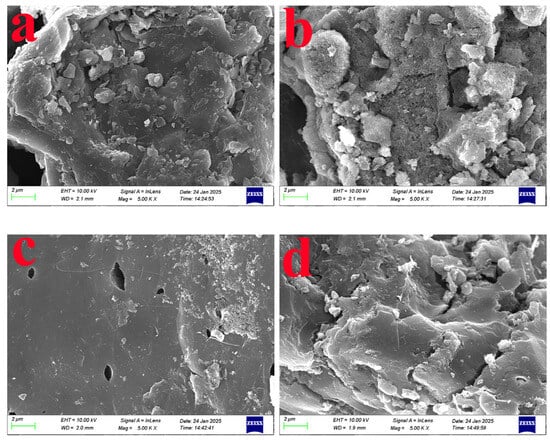
Figure 1.
SEM images of porous carbons: (a) SCC; (b) SCC-700-2; (c) SCC-800-2; and (d) SCC-900-2.
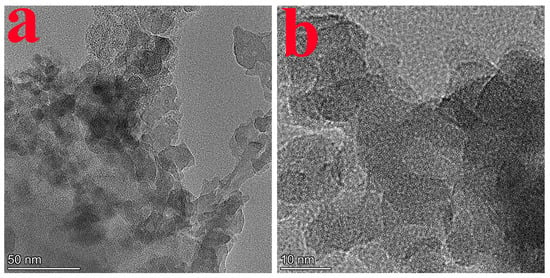
Figure 2.
TEM images of porous carbon SCC-700-2: (a) 50 nm; (b) 10 nm.
The graphitization degree of carbon microcrystals in porous carbon was systematically evaluated through Raman spectroscopy. As illustrated in Figure 3, according to the chemical structure assignments of the G-band and D-band in the Raman spectra in Section 2.3, the intensity ratio (ID/IG) quantitatively reflects the balance between structural disorder (ID) and graphitic ordering (IG)—a lower ratio typically signifies higher graphitization. As shown in Figure 3, the ID/IG ratios of raw coal and porous carbons ranged between 0.48 and 0.77. Notably, the raw coal sample (SCC) showed the lowest ID/IG ratio (0.48), indicating its relatively ordered structure with a higher graphitic crystallinity. As we increased the treated temperature to 700~900 °C, the ID/IG ratios of the KOH-activated porous carbons progressively increased (up to 0.77), suggesting that more defect structures were introduced in the carbon matrix after KOH activation at elevated temperatures. Combined with the results discussed in the morphological features (SEM and TEM), it is also demonstrated that defect structures introduced from carbonization and KOH activation would optimize the microporous structure that is critical for CO2 physisorption, while more severe heat treatment may further cause the coalescence of pore structures or even their collapse.
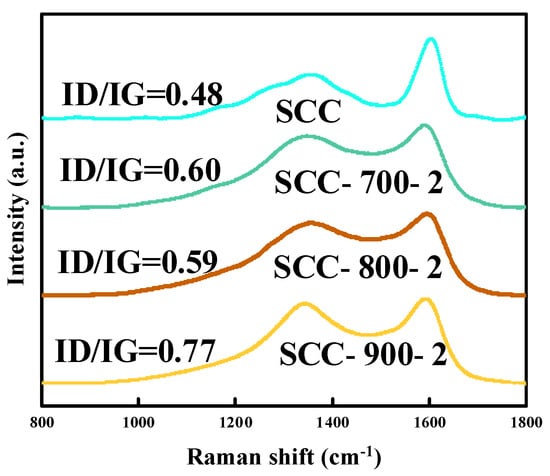
Figure 3.
Raman spectra of representative porous carbons.
The surface chemical composition and speciation of carbon and sulfur in the porous carbon were characterized using XPS, with the obtained spectra being charge-calibrated by referencing the C 1s peak (284.8 eV). The relative contents of carbon, oxygen, and sulfur were summarized in Table 2. It demonstrated a significant increase in carbon content and a progressive decline in sulfur content as the KOH-to-carbon ratio rose. The deconvolution of the C1s spectra (Figure 4a) resolved three components for all samples at around 284.8 eV, 285.6 eV, and 291.1 eV, which are assigned to the C-C/C=C bonds, C-N/C-O groups, and -COOR functionalities, respectively. The highest proportion of C-C/C=C bonds was overserved in sample SCC-700-2 from Figure 4a. The C-C/C=C bonds in the porous carbons helped enhanced the weak dipole interactions with the sp-hybridized carbon in CO2 through π–π interactions, thereby being favorable for their CO2 adsorption performance.

Table 2.
Elemental compositions calculated from XPS spectra of representative porous carbons (%).
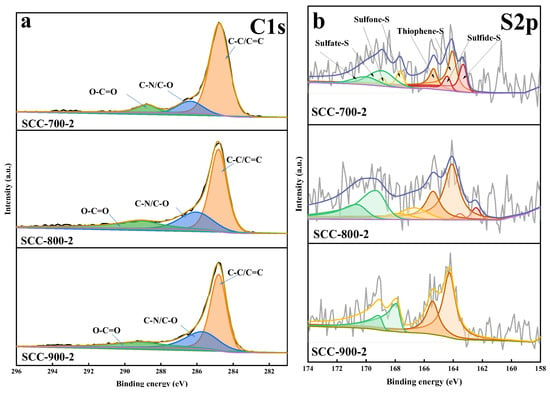
Figure 4.
Analyses of XPS spectra of the porous carbons: C1s (a) and S2p (b). The analysis of XPS spectrum of SCC is provided in Figure S3 in the Supporting Information.
The S2p spectra (Figure 4b) displayed four characteristic sub-peaks across all samples: the S2p orbitals will all form bipeaks due to the spin-orbit splitting in XPS as shown in Figure 4b. The binding energy ranges at around 162.1–163.6 eV, 164.0–164.4 eV, 167.0–168.3 eV, and >169.0 eV are characterized as sulfidic sulfur, thiophene sulfur, sulfones sulfur, and sulfates sulfur, respectively. The S2p3/2 peak areas of each sulfur species were used to calculate their relative contents in total sulfur and the results were listed in Table 3. The sulfide sulfur was abundant in sample SCC-700-2 and disappeared in sample SCC-900-2, indicating that a mild heat treatment temperature was favorable for the activation of sulfur with a low oxidation state. For thiophene sulfur as the main sulfur species in total sulfur, its relative contents were increasing at an elevated temperature. The relative contents of sulfone sulfur showed the opposite trend compared with thiophene sulfur. The incorporation of sulfur species—including disulfide (-S-S-), thioether (-S-), sulfone (-SO2-), and sulfoxide (-SO-)—may introduce chemical defects into the carbon matrix, while the presence of thiophene sulfur (five-membered aromatic rings) may create structural defects by disrupting the hexagonal graphitic lattice arrangement. These functional groups were likely acting as active sites for attracting CO2. However, the relative contents of sulfate sulfur, which was at a higher oxidation state, increased as the temperature rose, indicating that partial sulfur went through thermal oxidation and partial low-valent sulfur was converted into oxidized species. It is suggested that an enhanced oxidation reaction between sulfur and KOH may lead to sulfur loss via SO2 volatilization—a phenomenon corroborated by the elemental compositions as listed in Table 2. This escaping SO2 gas etched the carbon matrix to create pores; yet, an excessive gas release may obstruct the micropore channels, ultimately resulting in an expanded specific surface area coupled with a diminished micropore volume.

Table 3.
Curves-fitting results of XPS spectra of porous carbons (%).
3.2. Pore Structures of Porous Carbon
The porosity of porous carbons was analyzed through nitrogen adsorption–desorption measurements. Porous carbon materials in Figure 5a–c manifested hybrid Type I/IV isotherm characteristics, revealing the hierarchical pore architecture of porous carbons. At low relative pressures (P/P0 < 0.01), the N2 adsorption capacity increased sharply, indicating abundant micropores in the porous carbons that may be filled through monolayer adsorption. When relative pressures P/P0 reached >0.1, the increase in adsorption capacity leveled off with an emerging adsorption plateau, demonstrating the completion of surface monolayer coverage and the onset of multilayer adsorption. The desorption curves saw an obvious H4-type hysteresis loop confirming that carbon samples had slit-shaped micropores with constricted openings. As we elevated the activation temperature and KOH ratio, the low-pressure adsorption plateau (P/P0 = 0~0.2) became wider, which suggested a notable shift in the pore size distribution of the porous carbons. It is demonstrated from Figure 5d that the pore sizes of all samples ranged from 0.6 nm to 1 nm. The sample prepared at 800 °C developed more large micropores and mesopores, with the pore size distribution shifting rightward. The existing experimental studies indicated that the porous carbon with a pore size of around 0.7 nm was favorable for the CO2 capture [30]. In addition to the pore size distribution, surface characteristics such as the specific surface area and pore volume significantly influence the CO2 adsorption performance.
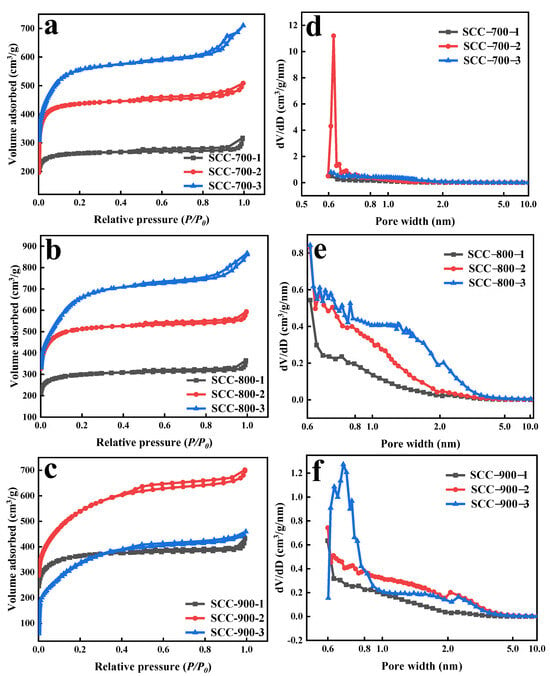
Figure 5.
N2 adsorption–desorption isotherms (a–c) and pore size distribution (d–f) of porous carbons.
The N2 adsorption data of porous carbons helped to reveal these surface characteristics, as summarized in Table 4. At a same activator KOH dosage, all carbon samples except SCC-900-3 showed gradual increases in SBET, Vt, and Vm with the increase in activation temperatures, suggesting that elevating the activation temperature is favorable for the formation of pore structure. The N2 adsorption analysis revealed significant porosity differences, with SCC-700-1 showing minimum porosity parameters (SBET: 804 m2/g, and Vt: 0.47 cm3/g), whereas SCC-800-3 exhibited the most favorable pore features with an SBET of 2209 m2/g, Vt of 1.31 cm3/g, and Vm of 0.99 cm3/g. These results indicate that higher activation temperatures promoted the decomposition of KOH, yielding higher surface areas and narrower micropores. The amount of the activator (KOH) also significantly affects both the pore structure and surface chemistry, thereby influencing the CO2 adsorption capacity. The variation in the surface characteristics of porous carbons with KOH dosage when fixing a certain temperature is also listed in Table 4. An increased KOH dosage induced structural changes similar to those caused by higher temperatures, demonstrating the equivalent importance of the activation temperature and activator dosage in the development of pore structures. Notably, the opposite result was obtained from the porous carbon prepared by using KOH/coal mass ratios of 3:1 KOH at 900 °C, which may be attributed to the collapse of the pore structure and pore enlargement due to the high activation temperature and excessive activator dosage. The higher intensity ratio of ID/IG in sample SCC-900-2 from the Raman spectra also indicated that excessive defected structures were generated by KOH etching, which may degrade its CO2 capture performance.

Table 4.
Surface structural characteristics and CO2 adsorption performance of porous carbons.
3.3. CO2 Adsorption of Porous Carbon
Figure 6 illustrated the CO2 adsorption behavior of the SCC-series samples, with the corresponding data summarized in Table 4. As discussed in Section 3.2, despite the well-developed pore structures supporting the CO2 capture potential, the porous carbon with the highest CO2 adsorption capacity (Table 4) did not have the optimal porosity features (SBET, Vt, and Vm), indicating that the pore structure alone does not determine the CO2 adsorption performance [31,32].
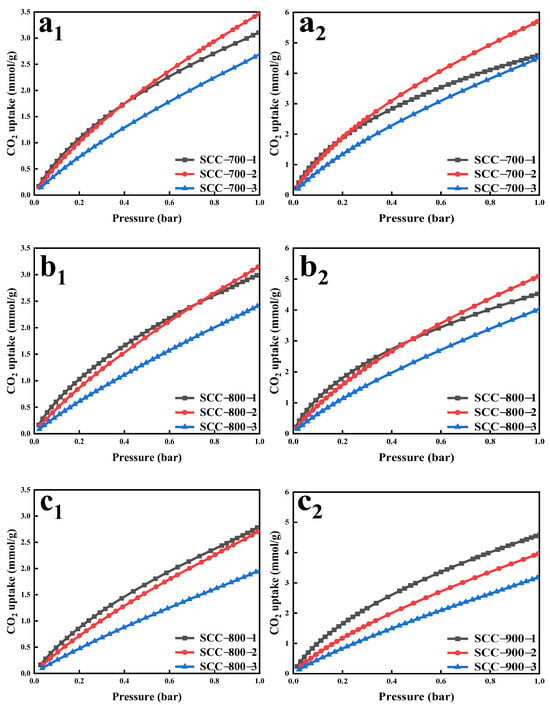
Figure 6.
The CO2 uptake of porous carbons at 25 °C (a1–c1) and 0 °C (a2–c2).
By increasing the pressure from 0 to 1 bar, the CO2 adsorption capacity progressively rises without reaching saturation at 1 bar, suggesting the potential for higher adsorption under elevated pressures. At lower pressures (P < 0.1 bar), the adsorption curves of porous carbons exhibited higher slopes than those at high pressures, indicating a strong affinity for CO2 molecules. At 700 °C and 800 °C, CO2 adsorption capacities initially increased, then decreased with rising KOH ratios. When the KOH dosage increases from 1× to 2×, its etching effect on the carbon structure brought about a large number of new-born microporous structures, with all microporosity proportions exceeding 85%, corresponding to the highest CO2 adsorption capacities observed at these activation temperatures. However, further increases in KOH dosage under 700 °C and 800 °C resulted in reduced CO2 adsorption performance to different degrees. This indicated that excessive KOH usage, while potentially bringing new microporous structures to be generated and increasing the SBET, simultaneously caused the coalescence of the pre-etched micropores and significantly lowered the microporosity proportion, ultimately impairing CO2 adsorption. At 900 °C, the carbon samples exhibited relatively lower CO2 adsorption capacities, which progressively declined with higher KOH dosages. This confirms that excessively high activation temperatures combined with excessive KOH dosages led to the over-activation of porous carbons, resulting in the collapse of the pore structure and a decrease in SBET, which was not favorable for CO2 capture.
The CO2 uptake of SCC-700-2, SCC-800-2, and SCC-900-2 were further discussed. Notably, sample SCC-700-2 demonstrated the highest CO2 adsorption capacities, reaching 5.69 mmol/g at 0 °C and 3.46 mmol/g at 25 °C, respectively, a value also superior to the other reported findings [33,34]. Elevated temperatures enhanced the interaction between KOH and the carbon matrix, leading to an increased SBET and Vm in the samples. However, the CO2 adsorption capacity gradually decreased under these conditions, demonstrating that the CO2 adsorption capacity of porous carbons was not solely determined by the physical structure of the surface. The analysis of the sulfur content variations by XPS in Section 3.1 gave insight into a positive correlation between the CO2 adsorption capacity and relative contents of certain sulfur species. This suggested that high temperatures intensify the interaction between KOH and surface sulfur, promoting the oxidation of lower-valence sulfur species into sulfur oxides. The lack of active sites introduced by sulfur species with relatively lower oxidation states are not favorable for CO2 capture. Consequently, the CO2 adsorption performance of porous carbons was jointly governed by the surface structure and sulfur composition. Thus, optimal CO2 adsorption requires the simultaneous optimization of both the pore architecture and surface chemistry.
The findings of this study were compared with those of previous research, and the results were summarized in Table 5. The comparison highlighted that porous carbons derived from sulfur-enriched coal under lower KOH dosages and activation temperatures achieve superior CO2 adsorption capacities. This observation offers a promising strategy for the development of in situ sulfur-doping porous carbons, demonstrating that balanced activation conditions (moderate temperature and activator ratio) can synergistically enhance both porosity and surface chemistry. Compared to conventional methods requiring aggressive activation or post-modification, this approach provides a more efficient pathway to optimizing the CO2 adsorption performance while preserving the sulfur functionality critical for gas–surface interactions.

Table 5.
Comparison of porous carbons with other reported adsorbents on the performance of CO2 adsorption.
In order to evaluate the CO2 adsorption stability of these porous carbons, five consecutive adsorption–desorption cycles were conducted on the representative sample SCC-700-2. As shown by the adsorption data (Figure 7a), the sample was still able to maintain an adsorption capacity of 3.37 mmol/g after five adsorption–desorption cycles, exhibiting a minimal capacity loss of only 2.6%. These results confirmed that SCC-700-2 has excellent cycling stability.
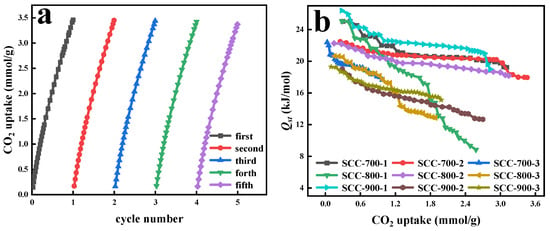
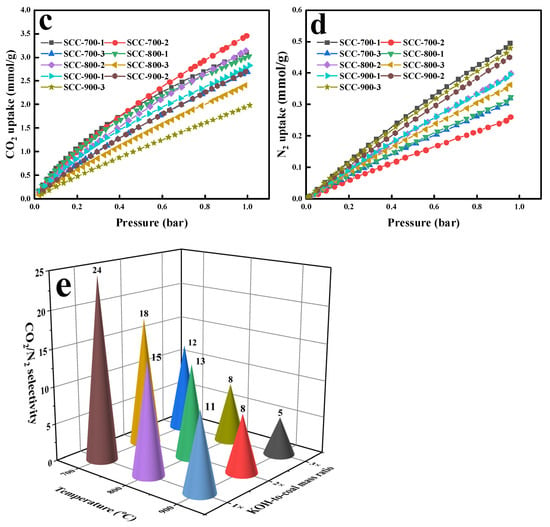
Figure 7.
The cycle performance of SCC-700-2 on CO2 capture (a), Qst of adsorption of porous carbons (b), CO2 and N2 adsorption of porous carbon at 25 °C (c) and (d), respectively, and CO2/N2 selectivity of porous carbons (e).
The results of the isosteric heat of CO2 adsorption (Qst) for all samples, plotted in Figure 7b, ranged from 11.5 to 26.4 kJ/mol at near-zero CO2 loading, consistent with typical physisorption-dominated processes. Among them, sample SCC-900-1 displayed the highest initial Qst value (26.4 kJ/mol), suggesting its regeneration required the largest energy input. However, since the overall Qst range remains in the physisorption regime, mild energy conditions are sufficient for regeneration, minimizing energy consumption. The Qst values of the samples saw a generally negative correlation with the CO2 uptake, indicating that the surface of these porous carbons was non-homogeneous and that the mild energy condition could meet the energy requirement for the regeneration of these adsorbents.
The CO2/N2 selectivity serves as a critical performance indicator for quantifying the ability of the adsorbents to preferentially capture CO2 from the flue gas while mitigating competitive adsorption from impurity gases. The adsorption test of N2 using the same method as the CO2 adsorption test were carried out on all samples and the results were plotted in Figure 7c. Based on these data, the CO2/N2 selectivity of all porous carbons was calculated using Equation (9) with the partial pressure of CO2 and N2 of 10:90. As shown in Figure 7d, selectivity values ranged between 5 and 24 across all porous carbons. Sample SCC-700-1 achieved the highest selectivity (24), demonstrating a superior potential for practical CO2 separation from flue gas. Notably, the selectivity of porous carbons gradually decreased under harsher activation conditions (higher temperatures or KOH dosages), likely due to the pore structure coarsening and the sulfur content reduction, which weakened the CO2 affinity while marginally enhancing the N2 uptake.
3.4. Analyses of Isothermal Adsorption Simulation and Thermodynamic Calculation
The CO2 adsorption equilibrium data of all porous carbons were analyzed through nonlinear curve fitting, and the results at 25 °C and 0 °C are presented in Figure 8 and Figure S4, respectively, with the corresponding parameters summarized in Table S2 (25 °C) and Table S3 (0 °C). All isotherm models demonstrated a strong correlation (R2 > 0.9) with the experimental CO2 adsorption data, where the three-parameter Redlich–Peterson equation achieved an optimal fit (R2 ≈ 1), contrasting with the Temkin model’s underperformance. The Langmuir model yielded R2 values below 0.999, suggesting that potential multilayer physisorption mechanisms rather than a single monolayer adsorption of CO2 may be involved. For all samples, the constant n in the Freundlich model exceeded 1, confirming that the surface of porous carbons was non-homogeneous, and this proved that CO2 adsorption was physisorption-dominated. The n values ranging between 0 and 10 further indicated that these porous carbons were favorable for CO2 adsorption. The KF parameters in the Freundlich model at 0 °C were higher than that at 25 °C, which reflected that the adsorption affinity binding strength between porous carbons and CO2 was stronger at lower temperatures, consistent with the experimentally observed higher adsorption capacities at 0 °C. In the Temkin model, the positive B values confirmed that the adsorption of CO2 by porous carbon was exothermic, and the R2 values above 0.9 demonstrated a linear decline in adsorption heat with the increasing surface coverage of porous carbons after CO2 adsorption.


Figure 8.
Isotherm modeling of porous carbon at 25 °C: (a1–c1) Langmuir, (a2–c2) Freundlich, (a3–c3) Temkin, (a4–c4) Sips, and (a5–c5) Redlich–Peterson.
Compared with those two-parameter models (Langmuir, Freundlich, and Temkin models), the three-parameter models showed a better fitting accuracy. The R2 values of the Sips model achieved a result higher than 0.9999, highlighting the heterogeneous surface nature of the porous carbon. The R-P model, integrating the Langmuir-type monolayer and Freundlich-style multilayer adsorption mechanisms, achieved the highest R2 closest to 1 for CO2 adsorption data fitting. Its characteristic parameter βRP (0 < βRP < 1) quantitatively confirmed the multilayer adsorption processes during CO2 sequestration in porous carbon.
The observed decline in the CO2 adsorption performance of the porous carbons with a temperature elevation (0 °C→25 °C) provided thermodynamic evidence for the exothermic nature of the physisorption process. To evaluate the energy changes during the CO2 adsorption process, thermodynamic calculations were performed using Equations (10) and (11), with the results summarized in Table 6. The negative enthalpy (ΔH) measurements quantitatively validated the spontaneous heat release during CO2 adsorption within the porous carbons. The magnitude of ΔH (exergy of CO2 adsorption, below 16 kJ/mol) aligned with the physisorption mechanisms, which typically involved weak van der Waals forces or dipole interactions. Concurrently, the negative ΔS suggested a reduced molecular randomness or an increased ordering of CO2 molecules during adsorption, and such an entropy change is characteristic of physisorption, where the adsorbed molecules adopt a more ordered configuration on the surface. The negative ΔG values further demonstrated the spontaneity of the physical adsorption process of CO2 on the porous carbons, with minimal variations in ΔG (−7.21 to −11.65 kJ/mol) across different samples and conditions, underscoring the thermodynamically favorable nature of CO2 adsorption on porous carbons. These collective thermodynamic parameters validated that the adsorption process was governed by physical interactions, ensuring efficient reversibility and practical feasibility for cyclic CO2 capture applications.

Table 6.
The calculation of ΔH, ΔS, and ΔG of porous carbons.
4. Conclusions
In this study, a series of porous carbon materials were synthesized via a straightforward one-step method using sulfur-enriched bituminous coal as the carbon precursor and KOH as the activating agent. The prepared porous carbons exhibited exceptional CO2 adsorption performance. The representative sample SCC-700-2 demonstrated the optimal CO2 capture performance under ambient conditions (25 °C, 1 bar), reaching 3.46 mmol/g. It is demonstrated that a moderate temperature and activator dosage are favorable for forming well-developed porous structures (high SBET of 1370 m2/g and Vm of 0.66 cm3/g) and preserving sulfur species with a lower oxidation state, which enhance gas–surface interactions. The sample SCC-700-2 demonstrated remarkable cyclic stability, preserving 97.4% of its original CO2 capture performance through five successive adsorption–regeneration cycles, confirming its excellent regenerative ability. Selectivity calculations for CO2/N2 revealed that sample SCC-700-1 exhibited a superior CO2 separation potential in flue gas environments. The calculated Qst of porous carbons ranged between 11.5 and 26.4 kJ/mol, consistent with physisorption mechanisms. Isotherm modeling further demonstrated that the Freundlich (two-parameter) and Redlich–Peterson (three-parameter) models achieved optimal fitting (R2 ≈ 1), indicating multilayer adsorption behavior on heterogeneous carbon surfaces. A thermodynamic analysis confirmed the spontaneous and exothermic nature of CO2 adsorption on porous carbons. This work presents a simplified preparation strategy of in situ sulfur-doping porous carbons that achieves excellent CO2 capture performance under milder activation conditions (lower temperatures and reduced KOH dosage), offering a practical pathway to take full advantage of high-sulfur coals.
Supplementary Materials
The following supporting information can be downloaded at: https://www.mdpi.com/article/10.3390/su17114952/s1, S1: The SEM images of porous carbons at 100 nm scale; Figure S1: The SEM images of porous carbons at 100 nm scale. S2: Deconvolution results of Raman spectra; Table S1: Peak assignments in Raman spectra of coal; Figure S2: The curving fitting results of Raman spectra of porous carbons. S3: The analysis of XPS spectrum of SCC; Figure S3: The S2p analysis of XPS spectrum of SCC. S4: Adsorption isotherm models; Table S2: Adsorption isothermal model parameters of all porous carbons at 25 °C; Table S3: Adsorption isothermal model parameters of all porous carbons at 0 °C; Figure S4: Isotherm modeling of porous carbon at 0 °C, (a1–c1) Langmuir, (a2–c2) Freundlich, (a3–c3) Temkin, (a4–c4) Sips, and (a5–c5) Redlich–Peterson. Reference [44] is cited in Supplementary Materials.
Author Contributions
Conceptualization, J.G. and W.-J.W.; data curation, Y.-P.M.; funding acquisition, J.G. and Y.-P.F.; investigation, J.G. and Y.-P.M.; methodology, X.-F.C.; supervision, Y.-P.F.; validation, Y.-P.F.; visualization, X.-F.C.; writing—original draft, J.G. and Y.-P.M.; writing—review and editing, W.-J.W. All authors have read and agreed to the published version of the manuscript.
Funding
This research received financial support from the National Natural Science Foundation of China (22408254), Fundamental Research Program of Shanxi Province (202303021222174, 202403021221136), Research Project Supported by Shanxi Scholarship Council of China (2023-148), Taiyuan University of Science and Technology Scientific Research Initial Funding (20232041), and Scientific and Technological Achievements Transformation Guidance Project of Shanxi Province (202304021301046).
Institutional Review Board Statement
Not applicable.
Informed Consent Statement
Not applicable.
Data Availability Statement
The data are contained within the article or Supplementary Material.
Conflicts of Interest
The authors declare no conflicts of interest.
References
- Nayak, S.; Goveas, L.C.; Selvaraj, R.; Vinayagam, R.; Manickam, S. Advances in the Utilisation of Carbon-Neutral Technologies for a Sustainable Tomorrow: A Critical Review and the Path Forward. Bioresour. Technol. 2022, 364, 128073. [Google Scholar] [CrossRef] [PubMed]
- Zhang, H.; Zheng, Y.; Cui, Y. Melamine Assisted Preparation of Nitrogen Doped Activated Carbon from Sustainable Biomass for H2 and CO2 Storage. Int. J. Hydrogen Energy 2023, 48, 17914–17922. [Google Scholar] [CrossRef]
- Zhang, B.; Huang, S.; Li, Y.; Shen, J.; Tian, X.; Ding, M. Highly Dispersed Cu on Hollow Spherical CeO2: An Efficient and Stable Catalyst for the RWGS Reaction. Appl. Catal. B Environ. Energy 2025, 366, 125003. [Google Scholar] [CrossRef]
- Zhao, Z.; Zhang, Y.; Othman, R.M.; Ha, W.; Wang, J.; Wang, T.; Zhong, L.; Wang, J.; Pan, W.P. CO2 Adsorption by Coal Fly Ash Zeolite and Modified Zeolite-Templated Carbon. Process Saf. Environ. Prot. 2024, 186, 151–165. [Google Scholar] [CrossRef]
- Gopalan, J.; Buthiyappan, A.; Abdul Raman, A.A. Insight into Metal-Impregnated Biomass Based Activated Carbon for Enhanced Carbon Dioxide Adsorption: A Review. J. Ind. Eng. Chem. 2022, 113, 72–95. [Google Scholar] [CrossRef]
- Ziobrowski, Z.; Rotkegel, A.; Ziobrowski, Z.; Rotkegel, A. Comparison of CO2 Separation Efficiency from Flue Gases Based on Commonly Used Methods and Materials. Materials 2022, 15, 460. [Google Scholar] [CrossRef]
- Hassan, T.N.A.T.; Shariff, A.M.; Pauzi, M.M.M.; Khidzir, M.S.; Surmi, A. Insights on Cryogenic Distillation Technology for Simultaneous CO2 and H2S Removal for Sour Gas Fields. Molecules 2022, 27, 1424. [Google Scholar] [CrossRef]
- Yuan, X.; Wang, J.; Deng, S.; Suvarna, M.; Wang, X.; Zhang, W.; Hamilton, S.T.; Alahmed, A.; Jamal, A.; Park, A.H.A.; et al. Recent Advancements in Sustainable Upcycling of Solid Waste into Porous Carbons for Carbon Dioxide Capture. Renew. Sustain. Energy Rev. 2022, 162, 112413. [Google Scholar] [CrossRef]
- Shi, C.; Li, L.; Li, Y. High-Throughput Screening of Hypothetical Aluminosilicate Zeolites for CO2 Capture from Flue Gas. J. CO2 Util. 2020, 42, 101346. [Google Scholar] [CrossRef]
- Nazir, G.; Rehman, A.; Hussain, S.; Mahmood, Q.; Fteiti, M.; Heo, K.; Ikram, M.; Aizaz Ud Din, M. Towards a Sustainable Conversion of Biomass/Biowaste to Porous Carbons for CO2 Adsorption: Recent Advances, Current Challenges, and Future Directions. Green Chem. 2023, 25, 4941–4980. [Google Scholar] [CrossRef]
- Xu, J.; Xie, Y.; Yao, Q.; Lv, L.; Chu, H. Advances in Sustainable Nano-Biochar: Precursors, Synthesis Methods and Applications. Nanoscale 2024, 16, 15009–15032. [Google Scholar] [CrossRef]
- Zang, P.; Tang, J.; Tao, Y.; Zhang, H.; Wang, X.; Cui, L.; Chen, S.; Zhao, P.; Dong, Y. K2CO3-Doped CaO-Based Sorbent for CO2 Capture: Performance Studies and Promotion Mechanisms. Chem. Eng. J. 2025, 505, 159233. [Google Scholar] [CrossRef]
- Wang, X.; Tarahomi, M.; Sheibani, R.; Xia, C.; Wang, W. Progresses in Lignin, Cellulose, Starch, Chitosan, Chitin, Alginate, and Gum/Carbon Nanotube (Nano)Composites for Environmental Applications: A Review. Int. J. Biol. Macromol. 2023, 241, 124472. [Google Scholar] [CrossRef] [PubMed]
- Soo, X.Y.D.; Lee, J.J.C.; Wu, W.Y.; Tao, L.; Wang, C.; Zhu, Q.; Bu, J. Advancements in CO2 Capture by Absorption and Adsorption: A Comprehensive Review. J. CO2 Util. 2024, 81, 102727. [Google Scholar] [CrossRef]
- Heo, Y.J.; Park, S.J. H2O2/Steam Activation as an Eco-Friendly and Efficient Top-down Approach to Enhancing Porosity on Carbonaceous Materials: The Effect of Inevitable Oxygen Functionalities on CO2 Capture. Green Chem. 2018, 20, 5224–5234. [Google Scholar] [CrossRef]
- Aghel, B.; Behaein, S.; Alobiad, F. CO2 Capture from Biogas by Biomass-Based Adsorbents: A Review. Fuel 2022, 328, 125276. [Google Scholar] [CrossRef]
- Quan, C.; Zhou, Y.; Wang, J.; Wu, C.; Gao, N. Biomass-Based Carbon Materials for CO2 Capture: A Review. J. CO2 Util. 2023, 68, 102373. [Google Scholar] [CrossRef]
- Wang, Y.X.; Ngo, H.H.; Guo, W.S. Preparation of a Specific Bamboo Based Activated Carbon and Its Application for Ciprofloxacin Removal. Sci. Total Environ. 2015, 533, 32–39. [Google Scholar] [CrossRef]
- Kumbhar, D.; Palliyarayil, A.; Reghu, D.; Shrungar, D.; Umapathy, S.; Sil, S. Rapid Discrimination of Porous Bio-Carbon Derived from Nitrogen Rich Biomass Using Raman Spectroscopy and Artificial Intelligence Methods. Carbon 2021, 178, 792–802. [Google Scholar] [CrossRef]
- Khuong, D.A.; Kieu, T.T.; Nakaoka, Y.; Tsubota, T.; Tashima, D.; Nguyen, H.N.; Tanaka, D. The Investigation of Activated Carbon by K2CO3 Activation: Micropores- and Macropores-Dominated Structure. Chemosphere 2022, 299, 134365. [Google Scholar] [CrossRef]
- Zhang, X.; Elsayed, I.; Song, X.; Shmulsky, R.; Hassan, E.B. Microporous Carbon Nanoflakes Derived from Biomass Cork Waste for CO2 Capture. Sci. Total Environ. 2020, 748, 142465. [Google Scholar] [CrossRef]
- Miao, Z.; Wu, J.; Niu, Y.; Guo, Z.; Guo, F.; Zhang, Y. Development of a Novel Type Hierarchical Porous Composite from Coal Gasification Fine Slag for CO2 Capture. Chem. Eng. J. 2022, 435, 134909. [Google Scholar] [CrossRef]
- Serafin, J.; Cruz, O.F. Promising Activated Carbons Derived from Common Oak Leaves and Their Application in CO2 Storage. J. Environ. Chem. Eng. 2022, 10, 107642. [Google Scholar] [CrossRef]
- Hayat, A.; Sohail, M.; Alzahrani, A.Y.A.; Ali, H.; Abu-Dief, A.M.; Amin, M.S.; Alenad, A.M.; Al-Mhyawi, S.R.; Al-Hadeethi, Y.; Ajmal, Z.; et al. Recent Advances in Heteroatom-Doped/Hierarchical Porous Carbon Materials: Synthesis, Design and Potential Applications. Prog. Mater. Sci. 2025, 150, 101408. [Google Scholar] [CrossRef]
- Hou, J.; Wen, S.; Chen, J.; Zhao, Q.; Wang, L. Large-Scale Fabrication of Biomass-Derived N, S Co-Doped Porous Carbon with Ultrahigh Surface Area for Oxygen Reduction. Mater. Chem. Phys. 2021, 267, 124601. [Google Scholar] [CrossRef]
- Nazir, G.; Rehman, A.; Park, S.J. Role of Heteroatoms (Nitrogen and Sulfur)-Dual Doped Corn-Starch Based Porous Carbons for Selective CO2 Adsorption and Separation. J. CO2 Util. 2021, 51, 101641. [Google Scholar] [CrossRef]
- Ma, C.; Lu, T.; Shao, J.; Huang, J.; Hu, X.; Wang, L. Biomass Derived Nitrogen and Sulfur Co-Doped Porous Carbons for Efficient CO2 Adsorption. Sep. Purif. Technol. 2022, 281, 119899. [Google Scholar] [CrossRef]
- GB/T 212-2008; Proximate Analysis of Coal. Standards Press of China: Beijing, China, 2008.
- GB/T 31391-2015; Ultimate Analysis of Coal. Standards Press of China: Beijing, China, 2015.
- Dantas, S.; Struckhoff, K.C.; Thommes, M.; Neimark, A.V. Pore Size Characterization of Micro-Mesoporous Carbons Using CO2 Adsorption. Carbon 2021, 173, 842–848. [Google Scholar] [CrossRef]
- Jin, C.; Sun, J.; Bai, S.; Zhou, Z.; Sun, Y.; Guo, Y.; Wang, R.; Zhao, C. Sawdust Wastes-Derived Porous Carbons for CO2 Adsorption. Part 2. Insight into the CO2 Adsorption Enhancement Mechanism of Low-Doping of Microalgae. J. Environ. Chem. Eng. 2022, 10, 108265. [Google Scholar] [CrossRef]
- Mochizuki, Y.; Bud, J.; Byambajav, E.; Tsubouchi, N. Influence of Ammonia Treatment on the CO2 Adsorption of Activated Carbon. J. Environ. Chem. Eng. 2022, 10, 107273. [Google Scholar] [CrossRef]
- Wang, Q.; He, D.; Mu, J. Hierarchically Porous Carbon from Cork with Tunable Pore Size and N-Doped Structure for Adsorption of Toluene and CO2. Sep. Purif. Technol. 2025, 360, 131256. [Google Scholar] [CrossRef]
- Gautam, S.J.; Vikram, S.; Dziejarski, B.; Sahoo, S. An Environmentally Friendly Synthesis Method of Activated Carbons Based on Subabul (Leucaena leucocephala) Sawdust Waste for CO2 Adsorption. J. Clean. Prod. 2023, 412, 137406. [Google Scholar] [CrossRef]
- Niu, J.; Shen, Y.; Zhang, H.; Li, L.; Guo, S. Preparation of Highly Microporous Activated Carbon by Utilizing Inherent Iron in Coal through CO2 and Steam Co-Activation for Improving CO2 Capture and Methylene Blue Removal. Fuel 2024, 371, 132069. [Google Scholar] [CrossRef]
- Wang, Y.; Zhang, C.; Tang, M.; Liu, J.; Yuan, J.; Zhao, Y.; Zhang, G. Preparation of N, S Co-Doped Carbon Nanotubes Composites by Coal Pyrolysis for the CO2 Capture. J. Environ. Chem. Eng. 2024, 12, 114452. [Google Scholar] [CrossRef]
- Maroto-Valer, M.M.; Tang, Z.; Zhang, Y. CO2 Capture by Activated and Impregnated Anthracites. Fuel Process. Technol. 2005, 86, 1487–1502. [Google Scholar] [CrossRef]
- Yuan, J.; Wang, Y.; Tang, M.; Hao, X.; Liu, J.; Zhang, G.; Zhang, Y. Preparation of N, O Co-Doped Carbon Nanotubes and Activated Carbon Composites with Hierarchical Porous Structure for CO2 Adsorption by Coal Pyrolysis. Fuel 2023, 333, 126465. [Google Scholar] [CrossRef]
- Li, Y.; Wang, Y.; Liu, N.; Wang, B.; Dong, R. Nitrogen and Sulfur Co-Doped Microporous Carbon Prepared by a Couple of Activating and Functionalized Reagents for Efficient CO2 Capture and Selective CO2/CH4 Separation. Colloids Surfaces A Physicochem. Eng. Asp. 2023, 658, 130732. [Google Scholar] [CrossRef]
- Hai, X.; Ma, B.; Wang, Q.; Bai, Y.; Lv, P.; Song, X.; Wang, X.; Yu, G. Coal Gasification Fine Slag as a Precursor to Prepare Mesoporous Carbon Materials by an Activation-Hydrothermal Two-Step Method for CO2 Adsorption. J. Environ. Manag. 2025, 373, 123590. [Google Scholar] [CrossRef]
- Ismail, I.S.; Singh, G.; Smith, P.; Kim, S.; Yang, J.H.; Joseph, S.; Yusup, S.; Singh, M.; Bansal, V.; Talapaneni, S.N.; et al. Oxygen Functionalized Porous Activated Biocarbons with High Surface Area Derived from Grape Marc for Enhanced Capture of CO2 at Elevated-Pressure. Carbon 2020, 160, 113–124. [Google Scholar] [CrossRef]
- Ma, C.; Bai, J.; Demir, M.; Hu, X.; Liu, S.; Wang, L. Water Chestnut Shell-Derived N/S-Doped Porous Carbons and Their Applications in CO2 Adsorption and Supercapacitor. Fuel 2022, 326, 125119. [Google Scholar] [CrossRef]
- Shi, S.; Liu, Y. Nitrogen-Doped Activated Carbons Derived from Microalgae Pyrolysis by-Products by Microwave/KOH Activation for CO2 Adsorption. Fuel 2021, 306, 121762. [Google Scholar] [CrossRef]
- Li, X.; Hayashi, J.I.; Li, C.Z. FT-Raman Spectroscopic Study of the Evolution of Char Structure during the Pyrolysis of a Victorian Brown Coal. Fuel 2006, 85, 1700–1707. [Google Scholar] [CrossRef]
Disclaimer/Publisher’s Note: The statements, opinions and data contained in all publications are solely those of the individual author(s) and contributor(s) and not of MDPI and/or the editor(s). MDPI and/or the editor(s) disclaim responsibility for any injury to people or property resulting from any ideas, methods, instructions or products referred to in the content. |
© 2025 by the authors. Licensee MDPI, Basel, Switzerland. This article is an open access article distributed under the terms and conditions of the Creative Commons Attribution (CC BY) license (https://creativecommons.org/licenses/by/4.0/).